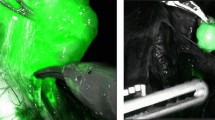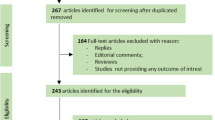Abstract
Robotic-assisted laparoscopic radical prostatectomy represents one of the most common operations in urologic oncology and involves several critical technical steps including pelvic lymph node dissection, cavernous nerve sparing and vesicourethral anastomosis. The quality of performing these steps is linked to functional and oncological outcomes. Indocyanine green [ICG] is a non-radioactive, water-soluble compound which allows for enhanced visualization with near-infrared fluorescence of both anatomical structures and vasculature during complex abdominal operations such as prostatectomy. During the last decade, several investigators have examined the value and role of ICG fluorescence during prostatectomy. In this review, we sought to evaluate the body of evidence for fluorescence-guided robotic prostatectomy as well as assess potential future areas of investigation with this technology.
Similar content being viewed by others
References
Van den Berg NS, van Leeuwen FW, van der Poel HG (2012) Fluorescence guidance in urologic surgery. Curr Opin Urol 22:109–120
Manny TB, Patel M, Hemal AK (2014) Fluorescence-enhanced robotic radical prostatectomy using real-time lymphangiography and tissue marking with injection of unconjugated indocyanine green: the initial clinical experience in 50 patients. Eur Urol 65:1162–1168
Wynne HA, Goudevenos J, Rawlins MD, James OF, Adams PC, Woodhouse KW (1990) Hepatic drug clearance: the effect of age using indocyanine green as a model compound. Br J Clin Pharmacol 30:634–637
Kaplan-Marans E, Fulla J, Tomer N, Bilal K, Palese M (2019) Indocyanine green [ICG] in urologic surgery. Urology 132:10–17
Obana A, Miki T, Hayashi K, Takeda M, Kawamura A, Mutoh T et al (1994) Survey of complications of indocyanine green angiography in Japan. Am J Ophthalmol 118:749–753
Schaafsma BE, Mieog JS, Hutteman M, van der Vorst JR, Kuppen PJ, Lowik CW et al (2011) The clinical use of indocyanine green as a near-infrared fluorescent contrast agent for image-guided oncologic surgery. J Surg Oncol 104:323–332
Alford R, Simpson HM, Duberman J, Hill GC, Ogawa M, Regino C et al (2009) Toxicity of organic fluorophores used in molecular imaging: literature review. Mol Imaging 8:341–354
Bates AS, Patel VR (2016) Applications of indocyanine green in robotic urology. J Robot Surg 10:357–359
Reinhart MB, Huntington CR, Blair LJ, Heniford BT, Augenstein VA (2016) Indocyanine green: historical context, current applications, and future considerations. Surg Innov 23:166–175
Van der Poel HG, Buckle T, Brouwer OR, Valdes Olmos RA, van Leeuwen FW (2011) Intraoperative laparoscopic fluorescence guidance to the sentinel lymph node in prostate cancer patients: clinical proof of concept of an integrated functional imaging approach using a multimodal tracer. Eur Urol 60:826–833
Manny TB, Pompeo AS, Hemal AK (2013) Robotic partial adrenalectomy using indocyanine green dye with near-infrared imaging: the initial clinical experience. Urology 82:738–742
Tobis S, Knopf J, Silvers C, Yao J, Rashid H, Wu G et al (2011) Near infrared fluorescence imaging with robotic assisted laparoscopic partial nephrectomy: initial clinical experience for renal cortical tumors. J Urol 186:47–52
Lee Z, Moore B, Giusto L, Eun DD (2015) Use of indocyanine green during robot-assisted ureteral reconstructions. Eur Urol 67:291–298
Lee Z, Simhan J, Parker DC, Reilly C, Llukani E, Lee DI et al (2013) Novel use of indocyanine green for intraoperative, real-time localization of ureteral stenosis during robot-assisted ureteroureterostomy. Urology 82:729–733
Inoue S, Shiina H, Mitsui Y, Yasumoto H, Matsubara A, Igawa M (2013) Identification of lymphatic pathway involved in the spread of bladder cancer: evidence obtained from fluorescence navigation with intraoperatively injected indocyanine green. Can Urol Assoc J 7:E322-328
Markuszewski M, Polom W, Cytawa W, Czapiewski P, Lass P, Matuszewski M (2015) Comparison of real-time fluorescent indocyanine green and [99m]Tc-nanocolloid radiotracer navigation in sentinel lymph node biopsy of penile cancer. Clin Genitourin Cancer 13:574–580
Hirche C, Murawa D, Mohr Z, Kneif S, Hunerbein M (2010) ICG fluorescence-guided sentinel node biopsy for axillary nodal staging in breast cancer. Breast Cancer Res Treat 121:373–378
Rossi EC, Ivanova A, Boggess JF (2012) Robotically assisted fluorescence-guided lymph node mapping with ICG for gynecologic malignancies: a feasibility study. Gynecol Oncol 124:78–82
Kelder W, Nimura H, Takahashi N, Mitsumori N, van Dam GM, Yanaga K (2010) Sentinel node mapping with indocyanine green [ICG] and infrared ray detection in early gastric cancer: an accurate method that enables a limited lymphadenectomy. Eur J Surg Oncol 36:552–558
Chennamsetty A, Zhumkhawala A, Tobis SB, Ruel N, Lau CS, Yamzon J et al (2017) Lymph node fluorescence during robot-assisted radical prostatectomy with indocyanine green: prospective dosing analysis. Clin Genitourin Cancer 15:e529–e534
Harke NN, Godes M, Wagner C, Addali M, Fangmeyer B, Urbanova K et al (2018) Fluorescence-supported lymphography and extended pelvic lymph node dissection in robot-assisted radical prostatectomy: a prospective, randomized trial. World J Urol 36:1817–1823
Papagiannopoulos D, Abern M, Wilson N, O’Block N, Raff L, Coogan C et al (2018) Predictors of infectious complications after targeted prophylaxis for prostate needle biopsy. J Urol 199:155–160
Cellini N, Luzi S, Mantini G, Mattiucci GC, Morganti AG, Digesu C et al (2003) Lymphatic drainage and CTV in carcinoma of the prostate. Rays 28:337–341
Boscolo-Berto R, Siracusano S, Porzionato A, Polguj M, Porcaro AB, Stecco C et al (2020) The underestimated posterior lymphatic drainage of the prostate: an historical overview and preliminary anatomical study on cadaver. Prostate 80:153–161
Stanik M, Capak I, Macik D, Vasina J, Lzicarova E, Jarkovsky J et al (2014) Sentinel lymph node dissection combined with meticulous histology increases the detection rate of nodal metastases in prostate cancer. Int Urol Nephrol 46:1543–1549
Jeschke S, Lusuardi L, Myatt A, Hruby S, Pirich C, Janetschek G (2012) Visualisation of the lymph node pathway in real time by laparoscopic radioisotope- and fluorescence-guided sentinel lymph node dissection in prostate cancer staging. Urology 80:1080–1086
Naraghi R, Becich MJ, O’Donnell W, Bahnson RR (1996) Routine frozen section of pelvic lymph node specimens prior to radical retropubic prostatectomy is unnecessary in patients with prostate specific antigen. Urol Oncol 2:141–145
Wawroschek F, Vogt H, Weckermann D, Wagner T, Hamm M, Harzmann R (2001) Radioisotope guided pelvic lymph node dissection for prostate cancer. J Urol 166:1715–1719
Grivas N, Wit EMK, Kuusk T, KleinJan GH, Donswijk ML, van Leeuwen FWB et al (2018) The impact of adding sentinel node biopsy to extended pelvic lymph node dissection on biochemical recurrence in prostate cancer patients treated with robot-assisted radical prostatectomy. J Nucl Med 59:204–209
Hruby S, Englberger C, Lusuardi L, Schatz T, Kunit T, Abdel-Aal AM et al (2015) Fluorescence guided targeted pelvic lymph node dissection for intermediate and high risk prostate cancer. J Urol 194:357–363
Van den Berg NS, Buckle T, KleinJan GH, Van der Poel HG, van Leeuwen FWB (2017) Multispectral fluorescence imaging during robot-assisted laparoscopic sentinel node biopsy: a first step towards a fluorescence-based anatomic roadmap. Eur Urol 72:110–117
KleinJan GH, van Werkhoven E, van den Berg NS, Karakullukcu MB, Zijlmans H, van der Hage JA et al (2018) The best of both worlds: a hybrid approach for optimal pre- and intraoperative identification of sentinel lymph nodes. Eur J Nucl Med Mol Imaging 45:1915–1925
Patel VR, Schatloff O, Chauhan S, Sivaraman A, Valero R, Coelho RF et al (2012) The role of the prostatic vasculature as a landmark for nerve sparing during robot-assisted radical prostatectomy. Eur Urol 61:571–576
Kumar A, Samavedi S, Bates AS, Giedelman Cuevas CA, Coelho RF, Rocco B, Palmer K, Patel VR (2015) Age stratified comparative analysis of perioperative, functional and oncologic outcomes in patients after robot assisted radical prostatectomy–A propensity score matched study. Eur J Surg Oncol 41(7):837–843
Mangano MS, De Gobbi A, Beniamin F, Lamon C, Ciaccia M, Maccatrozzo L (2018) Robot-assisted nerve-sparing radical prostatectomy using near-infrared fluorescence technology and indocyanine green: initial experience. Urologia 85:29–31
KleinJan GH, Sikorska K, Korne CM, Brouwer OR, Buckle T, Tillier C et al (2019) A prediction model relating the extent of intraoperative fascia preservation to erectile dysfunction after nerve-sparing robot-assisted radical prostatectomy. J Robot Surg 13:455–462
Van der Poel HG, de Blok W, Joshi N, van Muilekom E (2009) Preservation of lateral prostatic fascia is associated with urine continence after robotic-assisted prostatectomy. Eur Urol 55:892–900
Cacciamani GE, Shakir A, Tafuri A, Gill K, Han J, Ahmadi N et al (2019) Best practices in near-infrared fluorescence imaging with indocyanine green [NIRF/ICG]-guided robotic urologic surgery: a systematic review-based expert consensus. World J Urol 38(4):883–896
Pathak RA, Hemal AK (2018) Developing a personalized template for lymph node dissection during radical prostatectomy. Transl Androl Urol 7:S498–S504
Kim IY, Modi PK, Sadimin E, Ha YS, Kim JH, Skarecky D et al (2013) Detailed analysis of patients with metastasis to the prostatic anterior fat pad lymph nodes: a multi-institutional study. J Urol 190:527–534
Gandaglia G, Fossati N, Stabile A, Bandini M, Rigatti P, Montorsi F et al (2017) Radical prostatectomy in men with oligometastatic prostate cancer: results of a single-institution series with long-term follow-up. Eur Urol 72:289–292
Jang WS, Kim MS, Jeong WS, Chang KD, Cho KS, Ham WS et al (2018) Does robot-assisted radical prostatectomy benefit patients with prostate cancer and bone oligometastases? BJU Int 121:225–231
Dobbs RW, Halgrimson WR, Madueke I, Vigneswaran HT, Wilson JO, Crivellaro S (2019) Single-port robot-assisted laparoscopic radical prostatectomy: initial experience and technique with the da Vinci[[R]] SP platform. BJU Int 124:1022–1027
Agarwal DK, Sharma V, Toussi A, Viers BR, Tollefson MK, Gettman MT et al (2020) Initial experience with da Vinci single-port robot-assisted radical prostatectomies. Eur Urol 77:373–379
Dobbs RW, Halgrimson WR, Talamini S, Vigneswaran HT, Wilson JO, Crivellaro S (2019) Single-port robotic surgery: the next generation of minimally invasive urology. World J Urol 38(4):897–905
Van den Berg NS, Simon H, Kleinjan GH, Engelen T, Bunschoten A, Welling MM et al (2015) First-in-human evaluation of a hybrid modality that allows combined radio- and [near-infrared] fluorescence tracing during surgery. Eur J Nucl Med Mol Imaging 42:1639–1647
Kularatne SA, Thomas M, Myers CH, Gagare P, Kanduluru AK, Crian CJ et al (2019) Evaluation of novel prostate-specific membrane antigen-targeted near-infrared imaging agent for fluorescence-guided surgery of prostate cancer. Clin Cancer Res 25:177–187
Ikeda A, Nosato H, Kochi Y, Kojima T, Kawai K, Sakanashi H et al (2020) Support system of cystoscopic diagnosis for bladder cancer based on artificial intelligence. J Endourol 34:352–358
Checcucci E, Autorino R, Cacciamani GE, Amparore D, De Cillis S, Piana A et al (2020) Artificial intelligence and neural networks in urology: current clinical applications. Minerva Urol Nefrol 72:49–57
Inoue A, Ohnishi T, Kohno S, Nishida N, Nakamura Y, Ohtsuka Y et al (2015) Usefulness of an image fusion model using three-dimensional CT and MRI with indocyanine green fluorescence endoscopy as a multimodal assistant system in endoscopic transsphenoidal surgery. Int J Endocrinol 2015:694273
Funding
None.
Author information
Authors and Affiliations
Corresponding author
Additional information
Publisher's Note
Springer Nature remains neutral with regard to jurisdictional claims in published maps and institutional affiliations.
Rights and permissions
Springer Nature or its licensor holds exclusive rights to this article under a publishing agreement with the author(s) or other rightsholder(s); author self-archiving of the accepted manuscript version of this article is solely governed by the terms of such publishing agreement and applicable law.
About this article
Cite this article
Hasan, O., Reed, A., Shahait, M. et al. Fluorescence-guided radical prostatectomy. Int Urol Nephrol 54, 2775–2781 (2022). https://doi.org/10.1007/s11255-022-03307-0
Received:
Accepted:
Published:
Issue Date:
DOI: https://doi.org/10.1007/s11255-022-03307-0




